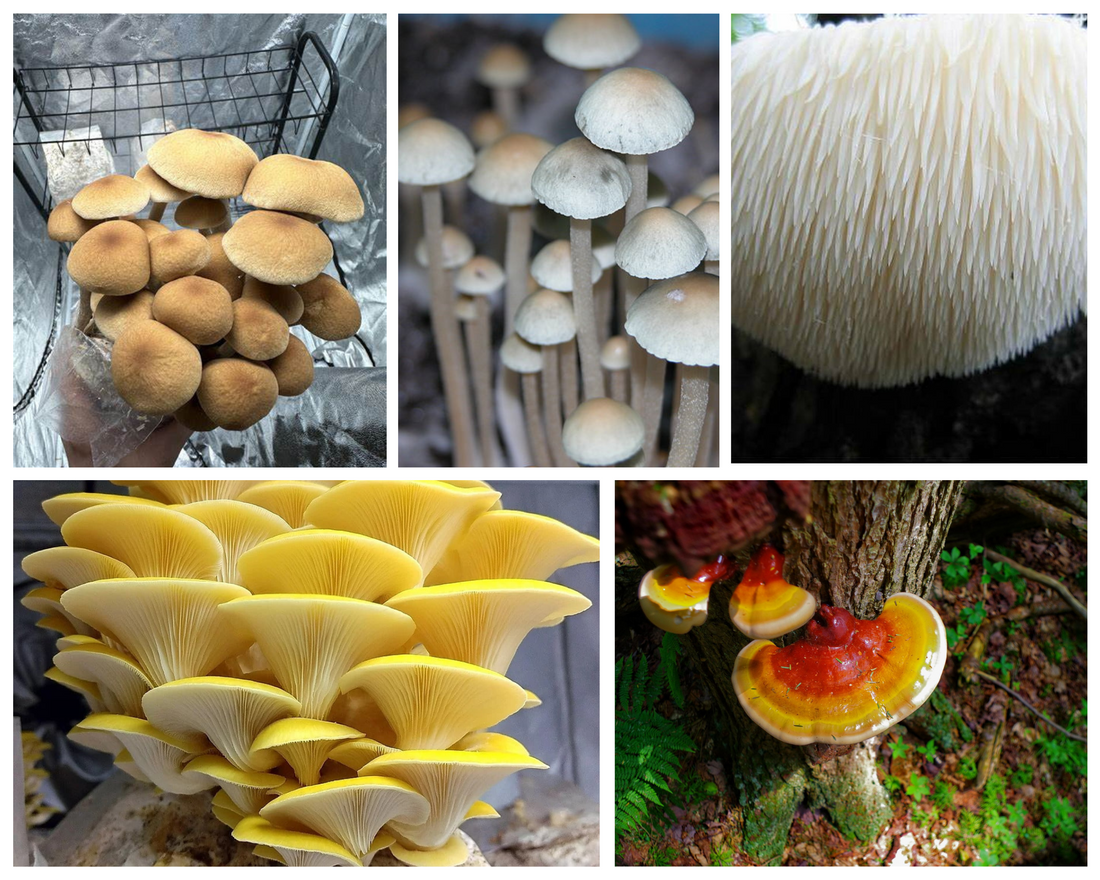
Beyond Cubensis
Share
5 Other Species You Can (And Should) Grow at Home
If you've mastered growing Psilocybe cubensis, you might be ready to expand your cultivation horizons. There are many fascinating mushroom species that you can grow at home—each with unique flavors, textures, and medicinal properties. Today, we'll explore five outstanding species: Oyster mushrooms, Lion's Mane, Pioppino, Reishi, and Panaeolus cyanescens. For each species, we’ll share substrate recommendations and practical growing tips so you can start your next cultivation adventure with confidence.
1. Oyster Mushrooms (Pleurotus spp.)
Overview:
Oyster mushrooms are prized for their delicate flavor and rapid colonization. They are extremely forgiving, making them perfect for hobby cultivators and those new to mushroom farming.
Recommended Substrate:
-
Straw: Pasteurized straw works exceptionally well.
-
Coffee Grounds: Pre-pasteurized coffee grounds can boost nutrition.
-
Coco Coir: Often used in combination with vermiculite for moisture retention.
Grow Tips:
-
Maintain a high humidity environment (around 85–95% during fruiting).
-
Ensure good fresh air exchange to prevent CO₂ buildup, which can lead to deformed caps.
-
Use a spawn-to-bulk ratio in the leaner range to promote rapid colonization, as oysters are fast growers.
2. Lion’s Mane (Hericium erinaceus)
Overview:
Lion’s Mane is not only visually striking with its cascading, white spines, but it also offers neuroprotective properties and a flavor profile often compared to seafood. It’s a gourmet and medicinal mushroom beloved in alternative medicine circles.
Recommended Substrate:
-
Hardwood Sawdust: Supplemented with a bit of bran for extra nutrition works best.
-
Stem Bundles: Some cultivators experiment with sterilized hardwood stems or logs.
Grow Tips:
-
Maintain a temperature between 65°F–75°F (18°C–24°C) during colonization.
-
Ensure high oxygen levels to prevent the formation of water droplets which can cause bacterial issues.
-
For fruiting, a light mist and cooler temperatures can help trigger the development of the characteristic spines.
3. Pioppino (Agrocybe aegerita)
Overview:
Also known as the black poplar mushroom, Pioppino has a rich, earthy flavor and a meaty texture. It’s a favorite in gourmet cooking for its robust flavor that pairs well with a variety of dishes.
Recommended Substrate:
-
Hardwood Sawdust: Particularly from poplar or oak, often supplemented with a small percentage of wheat bran for added nutrients.
-
Straw or Corncobs: Used in combination with sawdust for a more open substrate which helps with air circulation.
Grow Tips:
-
Keep the substrate in slightly cooler conditions (55°F–65°F or 13°C–18°C) during fruiting for optimum development.
-
Provide ample fresh air exchange to avoid excessive CO₂, which can inhibit proper cap formation.
-
Use shallow containers or bags to promote even colonization and allow the mycelium to effectively break down the substrate.
4. Reishi (Ganoderma lucidum)
Overview:
Reishi is revered in traditional medicine for its immune-boosting and stress-relieving properties. Known as the "Mushroom of Immortality," it’s more of a slow grower but well worth the effort for its potent bioactive compounds.
Recommended Substrate:
-
Hardwood Sawdust: Preferably from hardwood trees with a low nitrogen content.
-
Supplemented Logs: Fresh logs can also be used if inoculated properly; a hardwood log is ideal.
Grow Tips:
-
Reishi requires a longer incubation period; patience is key.
-
Maintain a temperature around 75°F–80°F (24°C–27°C) during colonization.
-
For fruiting, ensure high humidity and a well-ventilated environment to maintain the longevity and integrity of the corky caps.
-
Expect a denser, tougher fruiting body—perfect for tinctures and extracts rather than culinary use.
5. Panaeolus cyanescens
Overview:
Panaeolus cyanescens is known for its potent effects and rapid colonization when grown under ideal conditions. It requires a nutrient-rich, well-aerated substrate and is more suited for experienced cultivators due to its sensitivity.
Recommended Substrate:
-
Manure-Based Substrate: A highly nutritious compost blend, often enriched with straw or finely chopped organic matter, provides the complex nutrients required.
-
Moist, Well-Aerated Mix: Ensuring proper drainage and oxygen flow is key.
Grow Tips:
-
Maintain a slightly cooler environment during fruiting (around 68°F–72°F or 20°C–22°C) to encourage proper pinning.
-
Be meticulous with sterilization and pasteurization techniques—this species is more vulnerable to contamination.
-
Monitor humidity closely; too much moisture can lead to bacterial issues, while too little will impede colonization.
-
Its vigorous growth means it can out-compete contaminants if conditions are well-managed, but it also demands precise control.
Final Thoughts
Mushroom cultivation is a blend of art and science, and exploring species beyond the well-known Cubensis opens up a world of culinary, medicinal, and experiential possibilities. Whether you’re drawn to the fast, forgiving nature of Oyster mushrooms, the exotic appeal of Lion’s Mane, the gourmet taste of Pioppino, the venerable strength of Reishi, or the potent allure of Panaeolus cyanescens, there’s something here to enrich every cultivation journey.
Each of these species comes with its own set of challenges and rewards, and understanding the ideal substrates and growth conditions is the key to success. Experiment, take meticulous notes, and enjoy the process—each mushroom species is a gateway to a deeper understanding of the fascinating mycelial world.
If you have any questions or want to share your cultivation successes, drop a comment below
